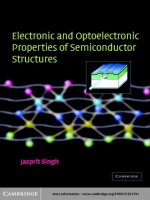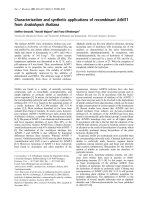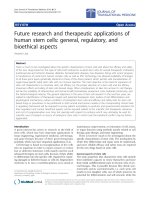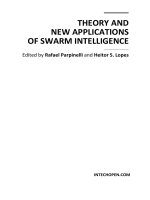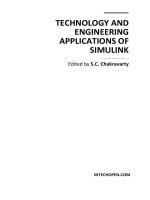ynthesis and optoelectronic applications of branched semiconductor nanocrystals
Bạn đang xem bản rút gọn của tài liệu. Xem và tải ngay bản đầy đủ của tài liệu tại đây (9.65 MB, 188 trang )
Synthesis and Optoelectronic Applications of
Branched Semiconductor Nanocrystals
NIMAI MISHRA
NATIONAL UNIVERSITY OF SINGAPORE
2013
Synthesis and Optoelectronic Applications of
Branched Semiconductor Nanocrystals
Nimai Mishra
(M. Sc., Chemistry, Indian Institute of Technology,
Madras)
A THESIS SUBMITTED
FOR THE DEGREE OF DOCTOR OF PHILOSOPHY
DEPARTMENT OF CHEMISTRY
NATIONAL UNIVERSITY OF SINGAPORE
2013
Declaration i
DECLARATION
The work in this thesis is the original work of Mr. Nimai Mishra
performed independently under the supervision of Asst. Prof. Chan Yin Thai,
Chemistry Department, National University of Singapore, between Jan , 2009 and
Jan, 2013.
The content of the thesis has been partly published in:
“Unusual Selectivity of Metal Deposition on Tapered Semiconductor
Nanostructures” Nimai Mishra, Jie Lian, Sabyasach Chakrabortty, Ming Lin, and
Yinthai Chan Chem. Mater., 2012, 24 (11), 2040–2046
Name Signature Date
Acknowledgement ii
ACKNOWLEDGEMENT
First and foremost, my sincere thanks to GOD for helping me out in my difficult
times of my PhD. I am grateful for his support and given strength to successfully
completion of 4 year journey named PhD.
I would like to thank to my advisor, Prof. Dr. Chan Yin Thai, for his
encouragement and supervision throughout my PhD study. He behaves more or
less like friend than Boss; always discuss science and other life stuff with us. I am
very fortunate to have his association almost all the valuable time of research. I
really want point out here that, time to time he used tell us story from his PhD
studies in MIT lab, those story were relay inspiring and helped me a lot. Due to
this we had great privilege that he always wants all of us to be become MIT level,
even though I failed to do so but it changed my attitude towards science a lot.
During last year MRS meeting in Boston he brought us to his MIT lab, described
the great discovery story, that open my eyes towards solving problem.
I also express my gratitude to Prof. Dr. Tze Chien Sum, Prof. Dr. Sow Chorng
Haur, Prof. Dr Yang Huiying, Prof Dr. Loh kian ping, Dr. Xing Guichuan Dr.
Tong Shi Wun, Dr. Jen It, Mr. Bablu Mukherjee and Dr. Bharathi for the fruitful
and enjoyable collaborative work during my candidature.
Heartily thanks to all lab mates, without them it won’t be possible to finish this
journey. Cloud remember our group dinner, BBQ party, Henderson walk tour, and
USA trip. I would like to thank all the present and past member of Dr. Chan’s
research group, Dr. Li Xinheng, Dr. Hu Mingyu, Dr. Bi Xinyan, Dr. Bhupendra
B. Srivastava, Dr. Giulia Adriani, Dr Sabyasachi Chakrabortty, Ms. Xu Yang, Ms.
Acknowledgement iii
Lian Jie, Ms. Liao Yile, Ms. Wu Wenya, Mr. Yang Jie An, Mr. Chan Teng Boon,
Mr. Syed Muhammad Saad, Mr. Lim Kiat Eng Kenny, Ms. Deng Xinying, Ms.
Tan Yee Min, Ms. Jessica Lim Jia Yin, Mr. Kelvin Anggara, Mr. Ong Xuanwei,
Mr. Chan Yong Wen.
Definitely my heart full thanks go to my family, my mother and wife. Tanks to
my Father, Late Dwijapada Mishra, unfortunately he is not able to see that I am
on verge of getting highest degree of my family. It is my mom’s ( Bharati Mishra)
hard work and sacrifice make whatever I am today, she is always want to give me
high education and support to become good, educated human being. I hope I did
some what she can be proud about it. I am thankful to my best friend, my life, my
partner in all time, without whose love I am almost lost. Tumpa, my beloved
Toom as early time my girlfriend and later as a wife support me like out of her
capacity that difficult to get in today’s world. Her charm full association in these
all years makes my life happier, easier and peacefully. I also thankful my family
members, including parent in law, sister and brother in law, little Neha (their
daughter) those make my time enjoy full and memorable. My gratitude’s goes to
all of them.
I would like to thanks all my friends in “Bhagavad Gita association in NUS”. This
community always serves as good plat form to become good human being and get
rid of stress in the time of crisis. Particularly like to thank Devkinadan Prabhu,
Dr. Niketa Chotai, Mr. Sandeep and Dr Bala for their help and support.
I am very much fortunate to have great association of “NUS Bengali community”
and its program like Swaraswati Puja, Bijaya celebration and all. Like to thanks
Acknowledgement iv
its entire member and the discussion on red table in canteen. Specially my thank
goes to Bijay for his friendship and love towards us. I am also thankful to Dr.
Tanay Pramanik, Dr. Pradipto Sankar Maity, Dr. Jhinuk Gupta, Dr. Animesh
Samanta, Dr. Sandeep Pasari, Dr. Krishnakanta Ghosh, Dr. Goutam K Kole, Mr.
Raj kumar Das, Mr. Bablu Mukherjee, Mr. Bikram Keshari Agrawalla, Dr. Tapan
Kumar Mistri, Dr. Hridoy Bera, Dr Amrita Roy, Mr. Debraj Sarkar, Dr. Sanjay
Samanta, Dr. Goutam Kumar Dalapati, Dr. Sadananda Ranjit, Dr. Srimanta Sarkar
, Mr. Deepal Kanti Das, Mr. Rghav, Mr Shubham Duttagupta, Mr. Shubhojit Paul
for the help and contributions you all have made during these years.
I am thankful to Ramkrishna Mission Singapore, Tagore society Singapore,
Bengali association Singapore, for organizing all the Indian festival and makes
Singapore like home.
Like to thanks all my teachers from school to NUS. Particularly thanks to JRC sir
of Katwa College, my teacher Prof S Kumar and Prof E Prasad from IITM. This
are the people encouraged me a lot to go for a PhD. I am also thankful to all my
QE committee, thesis examiner and all. Thank full to Dr. Wong Jock Onn (My
English teacher in NUS) for support regarding academic writing.
Lastly like to thank NUS Chemistry all staff member, Medicine EM unit staff,
DBS EM unit staff, IMRE SNFC
Finally want to thanks the NUS graduate scholarship, NUS Chemistry Conference
travel fellowship.
This thesis dedicated to most important people of life
My Mom and wife
Table of Contents vi
TABLE OF CONTENTS
TITLE PAGE
DECLARATION PAGE i
ACKNOWLEDGEMENTS ii
TABLE OF CONTENTS vi
SUMMARY x
LIST OF TABLES xi
LIST OF FIGURES xi
LIST OF ABBREVIATIONS xviii
CHAPTER 1: General Introduction
1.1 A General Introduction on Semiconductor Quantum dots: 2
1.1.1 Synthesis of Monodisperse QDs : 3
1.1.2 Surface Structure of the quantum dots: 6
1.1.2.1 Organically Capped Quantum Dots 6
1.1.2.2 Inorganically Passivated Quantum Dots 7
1.1.3. Properties of quantum Dots: 8
1.1.3.1Quantum Confinement Effects and Band-Gap 8
1.1.3.2. Luminescence Properties 11
1.2. Shape control beyond spherical dots: 12
1.2.1 Importance of the branched nanocrystal: 12
1.2.2 Engineering the Shape of QDs toward anisotropic structures: 14
1.2.2.1 Different methods for synthesis of the branched structures: 14
1.2.2.2 Multicomponent Colloidal branched structures: 15
1.2.2.3 Effects of strain in core/shell semiconductor
branched structures synthesis: 16
1.2.3 Exciton dynamics in semiconductor branched structures: 17
Table of Contents vii
1.2.4 Electronic states in semiconductor branched structures: 19
1.2.5 On the epitaxial growth of of anisotropic colloidal QDs: 21
1.2.6 Challenges in the synthesis of highly monodisperse 23
core/ shell branched structures:
1.2.7 Hybrid metal- branched semiconductor composites: 24
1.2.7.1 Overview of metal-branched semiconductors nanocrystals and its
Importance: 24
1.2.7.2 Challenges in selective metal deposition on branched structures: 25
1.2.8 Optoelectronic application of the tetrapod’s semiconductor quantum dots: 28
1.3 Thesis outline 30
1.4 References 32
CHAPTER 2: Synthesis of Branched semiconductor nanocrystal 38
2.1 Introduction 39
2.2 Experimental Section 44
2.3 Result and Discussion: 50
2.3.1: Maximizing the yield of CdSe seeded CdS tetrapods: 50
2.3.1.1: Effect of temperature: 51
2.3.1.2: Effect of surface capping ligand: 54
2.3.1.3: Effect of TOPS: 60
2.3.1.4: Summary of optimized conditions: 62
2.3.2: On the quantum yield of semiconductor tetrapods: 64
2.3.2.1: Optimizing the amount of alkyl phosphonic acids added: 64
2.3.2.2: Optimizing the ratio of short and long chain alkyl phosphonic acids: 66
2.3.3: Tuning of tetrapod arm dimensions: 68
2.3.4: Synthesis of zb-CdSe seeded CdTe tetrapods: 72
2.4 Conclusion 75
Table of Contents viii
2.5 References 76
CHAPTER 3: Unusual Selectivity of Metal Deposition on Tapered Semiconductor 80
Nanostructures
3.1 Introduction 81
3.2 Experimental Section 83
3.3 Results and Discussions 90
3.4 Conclusion 107
3.5 References 107
CHAPTER 4: Core-Seeded Semiconductor Tetrapods as Ultrasensitive Near-Infrared
Photodetectors 111
4.1 Introduction 112
4.2 Experimental Section 114
4.3 Results and Discussions 121
4.4 Conclusion 132
4.5 References 133
CHAPTER 5: Assembly of tetrapod shaped nanocrystals on graphene for hybrid solar cells
138
5.1 Introduction 139
5.2 Experimental Section 141
5.3 Results and Discussions 144
5.4 Conclusion 155
5.5 References 156
CHAPTER 6: Conclusion and Future Outlook 158
6.1 References 165
LIST OF PUBLICATIONS 167
Summary ix
Synthesis and Optoelectronic Applications of Branched
Semiconductor Nanocrystals
Summary
Nanoscale materials are currently being exploited as active components in a wide
range of applications in various fields, such as chemical sensing, biomedicine, and
optoelectronics. While conventional spherical colloidal nanocrystals have shown
promise in these fields due to their ease of fabrication, processibility and salient
optical properties, it may be envisaged that more applications may emerge if
nanocrystals can be synthesized in shapes of higher complexity and therefore
increased functionality. Shape control in both single- and multi-component
systems, which greatly impacts their physical and chemical properties, however,
remains empirical and challenging. This thesis essentially summarizes a body of
work done on the synthesis of different composition of core/shell tetrapod’s, study
the facet dependent metal deposition, as well as demonstrated the use of those
core/shell tetrapod’s as a optoelectronic material. In the first part of this thesis we
will elaborate on a systematic, surfactant-driven hot injection method to
synthesize CdSe seeded CdS nanoheterostructures with very high yield. This was
extended to other systems such as CdSe/CdTe and CdTe/CdS or PbSe/PbS and Cu
2-x
Se/ Cu
2-x
S via cation exchange techniques. In order to elucidate the reactivity
of the facets at the tips of such branched structures as a function of the shape of
the arms, we exposed the structures of various arm dimensions to controlled
amounts of metal precursors and discovered conditions in which the metal
nanoparticle can be deposited precisely at the tip of one of four arms with
symmetric reactivity. Finally, at the end of this thesis we will showcase the utility
Summary x
of such branched heterostructures in applications such as photodetectors and solar
cells.
List of Tables and Figures xi
List of Tables:
Table 2.1: Details of Synthesis of different arm and diameter of the CdSe seeded CdS Tetrapods:
……………………………………………………………………………………………………47
Table 3.1. Summary of the reaction conditions used for the synthesis of various CdSe seeded
CdS nanoheterostructures………………………………………………………………. …… 86
Table 5.1. Main photovoltaic parameters extracted from the devices consisted of different
photoactive materials. Rseries is evaluated from the inverse slope of dark current-voltage (JD-V)
characteristics of the photovoltaic device………………………………………………………151
Table 5.2. Main photovoltaic parameters extracted from the devices with different blend ratio of
PCDTBT and RGO-Tetrapod. R
series
is evaluated from the inverse slope of dark current
voltage(JD-V) characteristics of the photovoltaic
device………………………………………………………………………………………… 154
LIST OF FIGURES:
Figure 1.1 (a) QDs stabilized in the solvent by organic capping groups, which in this case,
primarily trioctylphosphine and trioctylphosphine oxide. (b) Low resolution TEM images of as-
synthesised CdSe quantum dots with zoomed in image showing the lattice fringes of a single
CdSe QD………………………………………………………………………………………. 2
Figure 1.2. The experimental setup for quantum dots synthesis by hot injection method……. 3
Figure 1.3 TEM images of colloidal semiconductor nanocrystals of different materials……….4
Figure 1.4 Schematic illustration of (a) an organic surface ligand capped QD, where some
surface atoms are unsatisfied and (b) an inorganically passivated QD. (c) An energy diagram
shows the band-gap difference of core and shell of the inorganic capped one……………… 7
Figure 1.5 schematic diagrams showing the effect of quantum confinement form bulk to nano
scale material. It can be seen that discrete energy levels are obtained due to a quantum
confinement effect……………………………………………………………………………… 9
.
Figure 1.6 (a) shows the confinement effect on CdSe QDs and how it follows the particle in a
box model. (b) an image of a real example of different sized CdSe QD emitting light from blue
to red. (c) On the right hand absorption spectra of CdSe with respect to size, taken from CB
Murray et.al work……………………………………………………………………………… 10
List of Tables and Figures xii
Figure 1.7 Comparison of the volume of QDs of different shapes…………………………….12
Figure 1.8. Schematic diagram showing the higher number of charge percolation pathways(Left)
and a lower number of inter-particle hopping (right)………………………………………… 13
Figure 1.9. (a) Schematic of the seeded approach synthesis of core shell tetrapods (b)-(d) TEM
image of CdSe/CdS , CdSe/CdTe, CdTe/CdTe tetrapods. Scale bar is 100nm……………… 16
Figure 1.10 schematic representations of the three different type of band alignments, depending
on their conduction and valence band edges in the core shell material. The plus and minus signs
represent the charge carriers (hole and electron, respectively). ………………………… … 18
Figure 1.11 (a) Schematic showing the electron and hole wave functions along one arm of the
CdSe/CdS tetrapods as the energy levels are calculated with an effective mass approach (b-d)
Color contour plots of electron and hole wave function distributions in………………………19
Figure 1.12. Electron and hole densities in the conduction and valence band of a CdSe tetrapod.
The CB
n
and VB
n
in the figure stand for conduction-band and valence-band states, respectively.
(a) CB1 (-2.540), (b) CB2 (-2.362), (c) CB3 (-2.360), (d) CB4 (-2.334), (e) CB5 (-2.234), (f)
CB6 (-2.230), (g) VB1 (-4.821), (h) VB2 (-4.897), (i) VB3 (-4.910), (j) VB4 (-4.916), (k) VB5 (-
4.950),and (l) VB6(-4.999) states………………………………………………………………20
Figure1.13 (c) The difference in energy levels between bulk WZ and ZB CdSe is clearly
demonstrated……………………………………………………………………………………21
Figure 1.14: Schematic diagrams show the possible growth mechanism of CdSe nanorods,
explaining the fact that the growth rates are faster on the Se terminated tips. The intrinsic dipole
moment direction is shown with the arrow…………………………………………………… 22
Figure 1.15. (a) TEM images shows the controlled growth of one tipped gold on CdSe nanorods.
(,b) With the help of gold concentration, both end dumb-bell shape on the same rod can be
achieved. (c,d) shows the HRTEM images of a single and dumb-bell shaped one………… 25
Figure 1.16. TEM images shows the uncontrolled growth of gold onto the tips of hyperbranched
CdTe particles………………………………………………………………………………… .26
Figure 1.17(a) Schematic shows the difference in reactivity of CdSe seeded CdS rod (b) On the
other hand CdSe seeded CdS tetrpods all four tips shows similar reactivity………………….27
List of Tables and Figures xiii
Figure 1.18 Schematic of the hybrid solar cell with the use of CdSe tetrpods, it also shows how
charge separation occurrs in the CdSe tetrapods………………………………………………28
Figure 2.1 (a) A HRTEM image of a CdSe tetrapod, with the fourth arm pointing towards us.(b)
A two-dimensional representation showing the structure of a tetrapod. The nuclei are zinc
blende, with wurtzite arms growing out of each of the four (111)-equivalent faces. (c,d) one pot
synthesis of CdTe tetrapods with zb core and wurtzite arm………………………………… 40
Figure 2.2. (a) Schematic representation of the seeded growth approach for the tetrapod
synthesis. (b) describes the different factors involved in the synthesis……………………… 42
Figure 2.3. (a) Schematic representation of the Zb CdSe synthesis ,(b) Typical low resulation TEM image
of the as-synthesized zb-CdSe, drop casted on the TEM grid.(b) Absorption (solid line) and PL (dotted
line) spectra of toluene solutions of ~ 3 nm diameter zb-CdSe seeds. (d) Corresponding XRD data of zb-
CdSe cores from (a). The vertical bars are referenced to PCPDS file No. 88-2346……………….45
Figure 2.4. Schematic representation of the necessity of core phase purity during the seeded
growth approach…………………………………………………………………………………51
Figure 2.5. TEM images exemplifying the decrease in the yield of tetrapods obtained as the
reaction temperature increases (a) 250
o
C (b) 280
o
C, (c) 320
o
C. (d) 350
o
C. Spherical dots was
observed in the case (a)………………………………………………………………………….53
Figure 2.6 TEM images exemplifying the increasing in the yield of tetrapods obtained as the Cd:
Oleic acid ratios are varied from (a) 1:1, (b) 1:2, (c) 1:3. (d) 1:4 (e) 1:6, (f) is a histogram
summarizing the yield of tetrapods as a function of the Cd to oleic acid molar ratio while all
other parameters are kept constant. The sample size in each case is on the order of ~ 300……55
Figure 2.7 TEM images exemplifying the decline in the yield of tetrapods obtained as the
Cd:HPA ratios are varied from (a) 1:0, (b) 1:1, (c) 1:2. (d) 1:3 (e) 1:6, (f) is a histogram
summarizing the yield of tetrapods as a function of the Cd to HPA molar ratio while all other
parameters are kept constant. The sample size in each case is on the order of ~ 300………….57
Figure 2.8. TEM images exemplifying the decline in the yield of tetrapods obtained as the
Cd:ODPA ratios are varied from (a) 1:0.2, (b) 1:0.4, (c) 1:0.6. (d) 1:1.2 (e) is a histogram
summarizing the yield of tetrapods as a function of the Cd to ODPA molar ratio while all other
parameters are kept constant. The sample size in each case is on the order of ~ 300………….58
Figure 2.9. TEM images exemplifying the decline in the yield of tetrapods obtained as the Cd:S
ratios are varied from (a) 1:0.5, (b) 1:2, (c)1:4 (d) 1:6. (e) is a histogram summarizing the yield
of tetrapods as a function of the Cd to S molar ratio while all other parameters are kept constant.
The sample size in each case is on the order of ~ 300………………………………………….61
Figure 2.10. (a)Y-shaped w-CdSe seeded CdS structures formed when w-CdSe seeds were
exposed to HPA, ODPA and a Cd:S ratio of 1:0.5. The branching of the nanorods may be
attributed to the partial conversion of wurtzite to zinc blende CdSe, resulting in the co-existence
of both phases within the same nanoparticle. (b) Resulting CdSe seeded CdS structures when the
same reaction conditions as (a) were used, except with a Cd: S ratio of ~ 1:6. It is readily seen
that the occurrence of branching is significantly reduced………………………………………62
List of Tables and Figures xiv
Figure 2.11. (a) Absorption (solid line) and PL (dotted line) spectra of toluene solutions of ~ 3
nm diameter zb-CdSe seeds.(b) Typical TEM images of as synthesized Zb-CdSe/CdS Tetrapods
with ~ 30 nm arm length and ~6 nm diameter from ~3 nm diameter Zb-CdSe……………… 63
Figure 2.12. A large scale view of the Low resolution TEM image of the CdSe seeded CdS
tetrapods. From typical sample sizes of ~500 particles, we deduced that the yield of tetrapods for
this synthetic strategy generally ranged from 95 % on average. ………………………………63
Figure 2.13. Change of the tetrapods yield from (a-c) where total ligand ( phosphonic acids)
amount decreased from 1:4, 1:2 to 1:1 (d) is a histogram summarizing the yield of tetrapods as a
function of the Cd to total amount of ligand ratio while all other parameters are kept constant.
The sample size in each case is on the order of ~ 300…………………………………………65
Figure 2.14 (a) zb-CdSe seeded CdS tetrapods synthesized using 100% HPA as ligands. The
yield on average is around 60% with respect to rods, bipods and tripods. (b) . zb-CdSe seeded
CdS tetrapods synthesized using 100% ODPA as ligands, while the yield of tetrapods for this
synthetic strategy was generally around 15 % on average. ………………………………… 66
Figure 2.15. Large field view of zb-CdSe seeded CdS tetrapods with cylinder-like arms
synthesized using HPA and ODPA as ligands. The size of the CdSe core is ~2.6 nm in diameter
while the CdS arms are about 6 nm long and ~ 30nm in diameter. In order to determine the yield
of tetrapods obtained, TEM samples with isolated, non-aggregated particles were analyzed. From
typical sample sizes of ~300 particles, we deduced that the yield of tetrapods for this synthetic
strategy generally ranged from 80 % on average. ……………………………………………………………………67
Figure 2.16. Typical TEM images of various CdSe seeded CdS nanotetrapods synthesized using
~2.9 nm diameter zb-CdSe cores, with varying diameter while keeping the length almost similar.
It can be seen that diameter is tuned from 5 nm to 20 nm (a-d) that leads to flower-like shape.
The change of the diameter was achieved by only changing the amount of the ligand. (g) graph
showing the variance of arm length and diameters within the same sample with changing % of
ODPA used…………………………………………………………………………………… 70
Figure 2.17. (a) Absorption (solid) and PL (doted) spectra of toluene solutions of the different
tetrapods as shown in figure 2.16(a-c),(b) Absorption (solid) and PL (doted) spectra of toluene
solutions of the different tetrapods as shown in figure 2.16(d-f)………………………………71
Figure 2.18. (a) Schematic of the synthesis process of the CdSe seeded CdTe tetrapods starting
from the zinc blende CdSe core. (b) Shows the band alignment of the CdSe and CdTe
semiconductors and also explains how this staggered band alignment helps to separate the
electron and hole. (c) The low resolution TEM image of as-synthesized zinc blende CdSe with an
average diameter 3.5 nm. (d) Low resolution TEM imge of the CdSe seeded CdTe tetrapods with
an average arm length of 30 nm and diameter around 6 nm. (e) is the absorption spectra of both
zb-CdSe (red) and zb-CdSe seeded CdTe tetrapods………………………………………… 73
Figure 2.19. A large scale view of the Low resolution TEM image of the CdSe seeded CdTe
tetrapods with an average arm length of 30 nm and diameter around 6 nm. From a typical sample
List of Tables and Figures xv
sizes of ~400 particles, we deduced that the yield of tetrapods for this synthetic strategy
generally ranged from 90 % on average. ………………………………………………………74
Figure 3.1. Illustration of representative architectures used to investigate selectivity of metal
deposition based on the facet distribution along their sides and vertices………………………91
Figure 3.2. Typical TEM images of various CdSe seeded CdS nanostructures synthesized using:
(a) ~2.9 nm diameter w-CdSe cores, HPA/ODPA (b) ~2.9 nm diameter w-CdSe cores, HPA/OA;
(c) ~3 nm diameter zb-CdSe cores, HPA/ODPA. (d) ~3 nm diameter zb-CdSe cores, HPA/OA;
(e) ~3 nm diame-ter zb-CdSe cores, OA/SA;………………………………………………… 92
Figure 3.3. Corresponding XRD data of CdSe seeded CdS heterstructures of figure 2 (a). The
vertical bars are referenced to PCPDS file No. 88-2346……………………………………….94
Figure 3.4. Absorption (solid line) and PL (dotted line) spectra of toluene solutions of the
different heterostructures shown in figure 2(a) to (d)………………………………………… 95
Figure 3.5. HRTEM images of zb-CdSe seeded CdS tetrapods with cylindrical- (a) and cone-like
(c) arms. Imaging along the axis of the arm reveals a well-defined hexagonal tip in (a) and a
distorted hexagon in (c). Corresponding magnified views of the arms showed that the side facets
are parallel to and deviated from the [100] zone axis in (b) and (d) respectively……………. .96
Figure 3.6. (a) HRTEM image of a CdSe seeded CdS tetrapod bearing cylinder-like CdS arms.
The hexagonal geometry of the CdS arm tip pointing perpendicular to the plane of the substrate,
as corroborated by the FFT image in the inset, is readily seen. (b) An atomic model of the
hexagonal tip shows six symmetric side facets (010), (100), (1-10), (0-10), (-100), (-110) and a
(002) vertex facet that correspond to those of wurtzite CdS………………………………… 97
Figure 3.7. HRTEM image of zb-CdSe seeded CdS tetrapods with wide, cone-like arms that
were syn-thesized using SA and OA as ligands. It is evident that the tip of the wide, cone-like
CdS arm features a distorted hexagon, unlike those of the zb-CdSe seeded CdS tetrapods with
cylinder-like arms………………………………………………………………………………98
Figure 3.8. TEM images of structures from Figure 1 exposed to high concentrations of Au
precursor. All of the reactions were done at room temperature for a fixed reaction time of 1.5
hours……………………………………………………………………………………………99
Figure 3.9 (a), (b) are the one-dimensional 1H NMR spectra of oleic acid in toluene-d8 and
worked up w-CdSe seeded CdS nanorods after ligand exchange with oleic acid and dispersed in
toluene-d8 respectively. Broadened and slightly shifted resonances in (b), especially around
~5.49 ppm, is indicative of the presence of oleic acid-bound nanoparticles, as described in Ref. 1.
Further confirmation that the phosphine-based ligands were successfully cap-exchanged by oleic
List of Tables and Figures xvi
acid was evidenced by 31P NMR measurements as shown in (c) and (d), which are data of
approximately same amounts of processed nanorods before and after ligand exchange with
excess oleic acid respectively. No discernible peak was found after ligand exchange with oleic
acid, which implies that the majority of the phosphine-based ligands were replaced. (e), (f) are
TEM images of ligand-exchanged (oleic acid capped) w-CdSe seeded CdS nanorods exposed to
relatively low and high concentrations of Au precursor respectively…………………………102
Figure 3.10. HAADF-STEM images of representative tetrapods with cone-like arms exposed to
a fixed Au precursor concentration and allowed to react at room temperature for (a) 5 min and
(b) 40 min; and at a much higher Au precursor concentration for 1.5 hr at (c) room temperature
and (d) 90
o
C respectively………………………………………………………………………103
Figure 3.11. (a) Reaction schematic to obtain hierarchically complex CdSe seeded CdS tetrapods
with Au at precisely one tip and Ag
2
S at the other three. (b) Representative HAADF-STEM
image of tetrapods with cone-like arms fabricated according to the strategy shown in (a). (c)
Magnified view of one of the tetrapods in (b), with the different tips labeled. (d),(e) are HRTEM
images of the different tetrapod arm tips showing the visible lattice fringes of the Ag
2
S (121) and
Au (111) planes with measured d-spacings of 0.26 nm and 0.24 nm respectively. Further
confirmation of the Au and Ag
2
S tip elemental composition by EDX is shown in (f) and (g)
respectively…………………………………………………………………………………… 106
Figure 4.1. (a) Representative TEM image of PbSe/PbS tetrapods with PbS arm dimensions of ~
24 nm in length and ~7 nm in diameter. (b) UV-Vis absorption spectrum of PbSe/PbS tetrapods
in toluene. (c) XRD data of as-synthesized PbSe/PbS tetrapods. The PbS reference standard
(JCPDS file no -00-005-0592) peaks are shown in red. (d) Area EDX data clearly showing the
strong presence of Pb and S, as well as the clear absence of any peaks corresponding to Cd or
Cu 122
Figure 4.2. A large scale view of the Low resolution TEM image of the PbSe seeded PbS
tetrapods. From typical sample sizes of ~500 particles, we deduced that the yield of tetrapods for
this synthetic strategy generally ranged from 95 % on average. …………………………… 123
Figure 4.3 (a) Schematic of the sequential cation exchange starting from CdSe/CdS tetrapods.(b-
d) Representation TEM images of CdSe/CdS, Cu
2-x
Se/ Cu
2-x
S and PbSe/PbS tetrapods. (e) The
color change of the tetapods from (b-d) is seen here. (f) Optical absorption spectra of the (b-d) in
black, blue and red color. …………………………………………………………………… 124
Figure 4.4: FTIR spectra of the pure toluene ( black) and nanocrystals dispersed in toluene. (a)
Carbonyl stretching vibration of oleic acid was to be found at 1715 cm
-1
. The results indicate that
oleate ligands attached to PbSe-PbS nanocrystals .(b) phosphonate stretching vibration of the
phosphonic acids was to found at 1219 cm
-1
, which indicates the presence of this ligand on to the
PbSe-PbS surface………………………………………………………………………………125
List of Tables and Figures xvii
Figure 4.5. (a) Schematic of the tetrapod-based IR photodetector based on a lateral electrode
configuration. (b), (c) are the top and cross-sectional SEM images respectively of densely-
packed PbSe/PbS tetrapod films drop-casted under ambient conditions from a solution of
tetrapod particles dispersed in toluene. The thickness at the central region of the film was about 3
µm. (d) Graph of photocurrent vs applied voltage at different excitation intensities: 570 μW/cm
2
(red), 532 nm (green), 808 nm (red), 1064 nm (black). The dark current curve is shown in black.
The excitation wavelength was fixed at 808 nm 127
Figure 4.6. (a) Responsivity of the PbSe seeded PbS tetrapod-based photodetector (in black) as a
function of excitation intensity for an excitation wavelength of 808 nm. The corresponding
photocurrent density (in blue) measured is plotted as a reference. (b) The temporal response of
the photodetector at an excitation intensity of 570 μW/cm
2
. (c) Enlarged view of the figure 4.6b,
shows 100ms response time 129
Figure 4.7 (a) Schematic of the band alignment of the PbSe seeded PbS tetrapods, with respect to their
bulk values. (b) Charge carrier recombination of the electron and hole shown here. (c) the carrier
recombination lifetimes was extracted from this curve……………………………………… 131
Figure 5.1. TEM images (a) show the homogeneous dispersion of the tetrapods in high yield
(90%) and (b) the tetrapods are consisting of a CdSe core enclosing four CdTe arms.
Discrepancy of tetrapods coverage on reduced graphene oxide (RGO) (c) without and (d) with
oleylamine treatment are indicated from SEM images. (e) and (f) Absorption and PL spectra of
thin films comprising PCDTBT and RGO-Tetrapod in different blend ratio………………….146
Figure 5.2: Effect of different PCDTBT:RGO-Tetrapod blend ratio (a) to (e) 1:1, 1:3, 1:5, 1:7
and 1:9 on the film morphologies as shown from plane view and 3-D view of 1 x 1 m2 atomic
force microscopic images. All films are annealed at 150 °C for 10 minutes. (f) Corresponding
root mean square roughness values are plotted…………………………………………………148
Figure 5.3. (a) Photovoltaic device configuration used in the current study. (b) Schematic energy
level diagram in the device. Under light illumination intensity of 100 mW/cm
2
, J-V
characteristics of the devices with (c) different photoactive layer and (d) PCDTBT:RGO-
Tetrapod in various blend ratio are plotted…………………………………………………… 150
List of Abbreviations xviii
LIST OF ABBREVIATIONS:
Abbreviation Actual name
HDA 1-hexadecylamine
ODE 1-octadecene
HDDO 1,2-hexadecanediol
CB Conduction Band
°C degree centigrade
DIPA Diisooctylphosphinic acid
DDA Dodecylamine
EDX Energy-dispersive X-ray spectroscopy
e- electron
EELS Electron Energy Loss Spectroscopy
eV Electronvolts
EFTEM Energy-Filtered Transmission Electron
Microscopy
GM Goeppert-Mayer
g gram
HRTEM High Resolution Transmission Electron
Micoscopy
HAADF-STEM High Angle Annular Dark Field-Scanning
Transmission
Electron Microscopy
h+ hole
KHz Kilo Hertz
kV Kilovolts
LA Lauric aldehyde
List of Abbreviations xix
LED Light Emitting Diodes
μM Micro molar
μL Micro litre
NCs Nanocrystals
nm nanometer
NRs Nanorods
NIR Near Infra Red
DDAB n-dodecylammonium bromide
HPA n-hexylphosphonic acid
ODPA n-Octadecylphosphonic acid
PL Photoluminescence
QDs Quantum Dots
QYs Quantum Yields
RBF Round bottom flask
RGO Reduced graphene oxide
TOAB Tetraoctylammonium bromide
TRPL Time Resolved Photoluminescence
TEM Transmission Electron Micoscopy
TOP Trioctylphosphine
TOPO Trioctylphosphine oxide
UV Ultra Violet
Chapter 1: General Introduction 1
CHAPTER 1
Introduction
Chapter 1: General Introduction 2
1.1 A General Introduction on Semiconductor Quantum dots:
Colloidal semiconductor nanocrystals, also known as „„quantum dots‟‟ (QDs), are
inorganic materials composed of atoms ranging from a few hundred to a few
thousand in number, capped by an organic layer of surfactant molecules known as
ligands (Figure 1.1a).
1
Their small size within 1-10 nm results in an observable
quantum confinement effect, which causes the energy levels near the band edge to
become discrete. This quantum confinement effect normally occurs when the
particle size is comparable to its bulk Bohr exciton radius (As example 56 Å for
the CdSe). The size-dependent optical properties of QDs have been extensively
researched on over the past two decades and have been found to be very
promising in various applications such as light-emitting diodes (LEDs),
2
solar
cells,
3
lasers
4
and bio-imaging.
5
. Figure 1.1b shows the low resolution
transmission electronic microscopy image (TEM) of typical CdSe QDs with a
high degree of monodispersity, and a zoom-in picture showing its crystalline
nature. The next section will briefly discuss on the synthesis of quantum dots.
Figure 1.1 (a) QDs stabilized in the solvent by organic capping groups, which in this
case, primarily trioctylphosphine and trioctylphosphine oxide. (b) Low resolution TEM
images of as-synthesised CdSe quantum dots with zoomed in image showing the lattice
fringes of a single CdSe QD.
a
)
20 nm
QDqQDnano
crystals
b)
Chapter 1: General Introduction 3
1.1.1 Synthesis of Monodisperse QDs :
The first insight into the quantum size effect of CdSe materials was observed in
the early 1930s by Roksby.
6
About two decades later, researchers from Bell
Laboratories and from IBM invented the quantum well, which exhibited 1D
quantum confinement. In 1983, Brus et al. at Bell Laboratories synthesized CdS
crystalline quantum dots from inorganic salts at room temperature and studied
their optical properties.
7
After this first chemical synthesis of colloidal CdS
quantum dots, it took about ten years before Murray et al in 1993 at MIT
introduced the hot injection method
Figure 1.2. The experimental setup for quantum dots synthesis by hot injection
method.
(as depicted in Figure 1.2) to produce monodisperse spherical and highly
crystalline QDs.
8
In this synthesis procedure, pyrophoric organometallic
precursors of the cadmium chalcogenide were rapidly injected into a mixture of
degassed, high boiling-point organic solvent and surfactants at elevated
temperatures of ~360
o
C under inert conditions. The rapid thermal decomposition
Chapter 1: General Introduction 4
of the precursors leads to the nucleation and growth of QDs in accordance with La
Mer‟s crystal growth model. The ligands (also known as capping groups) control
the nucleation and growth rates by dynamically binding to and coming off the
surface of the QDs, as well as to the constituent QD precursors in solution. This
enables control over the size and shape of the QDs. The overall process can be
Figure 1.3 TEM images of colloidal semiconductor nanocrystals of different
materials. Adapted with permission from ref. 9.

